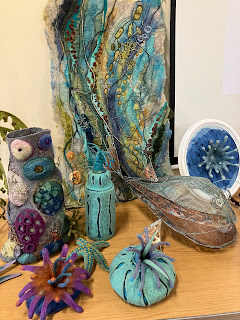Our September Meeting
This month there was a lot of activity in the hall. Two new stitch clubs started with Liz leading an introduction to wet felting and Jacqueline getting a group started with traditional Jacobean crewelwork.
Liz had provided all the equipment and materials for the wet felting process including felt 'tops' in a range of vibrant colours, bubble wrap, plastic sheeting and dowels as well as water/soap sprayers for wetting the wool. The first session was all about playing with colours and learning how the wet felting process worked. In brief the process involved laying thin criss-cross layers of wool 'roving' onto the rough side of bubble wrap to create a white base and then laying coloured wool on top to create a coloured surface. Other embellishments could be added including glittery thead 'angelina', tiny wool balls 'nepps', silk strands, thread offcuts and twisty wool 'locks'.
Liz layering coloured wool tops onto white wool layers at the start of the wet felting process
The next step was to thoroughly wet the fibres and then add another layer of bubble wrap before rolling the layers around a dowel. Then there was a lot of vigorous rolling, unwrapping, rotating and re-rolling to encourage the fibres to bond together and then shrink. When Liz was happy we'd done enough we could rinse our pieces in water (and at home water with white vinegar) and allow them to dry. It was lots of fun and we are looking forward to next time when we can attempt more considered 'landscapes'.
Crewelwork is a type of surface embroidery using fine two-ply or one-ply wool. It is associated with England in the 17th and 18th Century and the traditional design styles are often referred to as Jacobean. They typically comprise subtly shaded stylised floral and animal designs. Jaqueline produces very lovely crewel work and for her novice group she had produced a simple kit comprising a piece of cotton twill, a pattern and wools (3 shades in each of three colours).
Jaqueline's Crewelwork sample
The first part of the process involved learning how to transfer the design using a traditional method of tracing, pricking and pouncing.
Preparing the design for stitching
After this participants were able to put the fabric into hoops ready for stitching. It will be interesting to see how they progress over the next two sessions.
As always there was a lot of stitching and embroidering going on in the hall by members who were working on their own pieces. There is such a wide range of talent but Jenny's sewing caught my eye this month. She was working on linen with linen threads and feature buttons and was producing a very 'scandi' piece!
Jenny's piece from a Nordiska (Studio Flax) pattern - a circle sampler stitched with linen embroidery threads.
Competition time!
The autumn competition was for something original and there were many wonderful pieces on display. Celia's very striking 3-d mixed media piece worked on a gnarled wood base was chosen as the winner of the Ida Barber trophy.
Celia's 3-d piece
Other competition entries
The Travelling Book
This month Nicky had worked on the travelling book. She had produced some detailed information and lovely samples of traditional and modern blackwork embroidery.
My "F Plan" Diet: fabric, fibre and felting - Karen Lane
In the afternoon Karen who is a talented feltmaker and textile artist gave an illustrated talk. She had brought along a large selection from her earliest experiments with David Hockney inspired applique hangings through to her more recent sculptural felted work. We were interested to see the range of thoughtful pieces made in response to competitive challenges set by the various groups Karen had attended. With no formal background in stitching/embroidery she had developed a highly original style using unusual fabrics and experimental techniques. She was clearly a creative and playful maker who was also learning from established felt artists so as to improve her technical abilities and move her practice forward. She was also making incredible 3-d pieces using lutradur and tyvek fabrics which allowed her to sculpt and burn away sections to create unusual textures and surface effects. Mind blowing! More information about her work is available on www.lincsinstitches.com
Work created by Karen Lane
Our next meeting will be on Saturday 5th October. Visitors and new members are always welcome.














